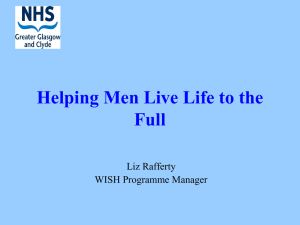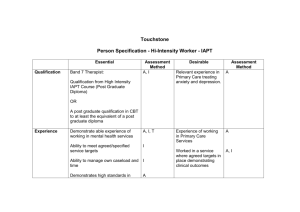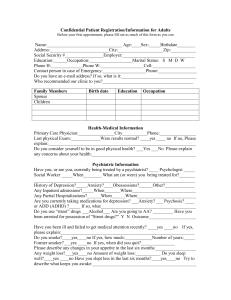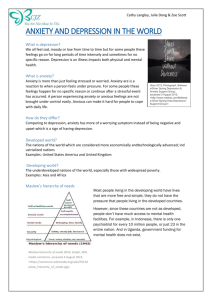Doncaster Report
advertisement
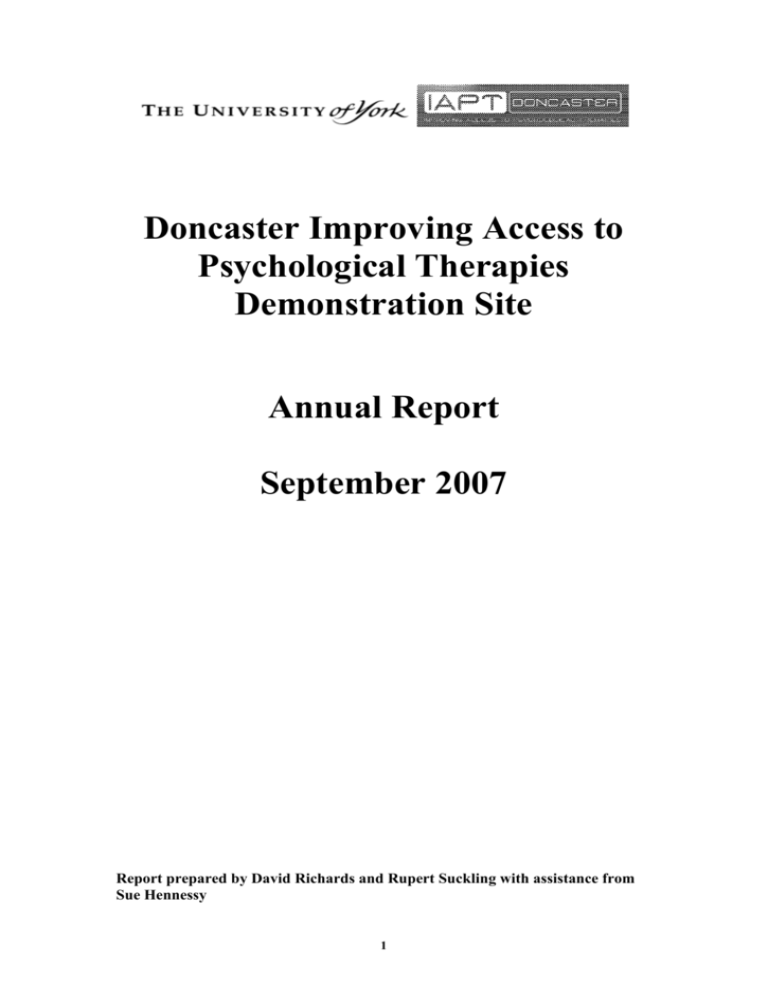
Doncaster Improving Access to Psychological Therapies Demonstration Site Annual Report September 2007 Report prepared by David Richards and Rupert Suckling with assistance from Sue Hennessy 1 Executive Summary Right Numbers Almost 4000 people have been referred at a rate which is now stable at just over 300 per month. 71% of these referrals have been seen and assessed following an initial and very rapid duty manager contact to discuss the service with the patient and, where necessary, the referrer. The majority of people referred come from general practitioners, two thirds are women and those referred have an average age of 38 years. Although Doncaster does not have a richly diverse black and minority ethnic population, referrals of people from BME groups is slightly under that which might be expected if people referred were to reflect the diversity of Doncaster’s population. General practitioners identify 94%of people referred as having a primary problem of depression, with 86% a secondary problem of anxiety. This is confirmed by clinical measures taken at assessment where the majority of people referred (74%) have mixed depression and anxiety, 9% depression alone and 5% anxiety alone. 12% of people referred do not have depression or anxiety. The severity of depression and anxiety symptoms identified by those people referred is high: 62.5% of people referred have moderately severe or severe symptoms of depression; 52.6% have symptoms of severe anxiety (there is no corresponding category of moderately severe anxiety). The numbers of people with a diagnosis of depression or anxiety, and the severity of symptoms experienced by these people does not seem to be any different whether the person referred has had their symptoms for a relatively short duration (recent onset cases – ROC) or for much longer. This observation needs testing further. Right Services The Doncaster model includes evidence based low- and high-intensity cognitive behaviour therapy organised in a stepped care system delivered by an evidence based collaborative care protocol. Almost 11,000 clinical contacts have been conducted by Doncaster workers, 58% of these on the telephone with 52% for self-help interventions. 96% of people assessed and/or treated have received at least one face to face contact with a worker, 62% at least one telephone contact. The average time required for telephone treatment contacts is under 24 minutes per contact; for face to face contact this time is 52 minutes. 2 74% of people treated by the Doncaster service have received at least one session of the low-intensity Depression Recovery Programme delivered by case managers, 42% the anxiety self-help programme and 35% medication management. Computerised CBT has been utilised by 177 (6.3%) of people assessed. Only 499 sessions of individual high-intensity cognitive behaviour therapy have been delivered in Doncaster to a total of 97 (3.5%) people assessed. Right Time All people referred are contacted within 24-48 hours where possible by a duty manager to discuss the service. Where necessary, discussions are also held with the referrer and with other services, should all agree that the needs of the person referred will not be met by the IAPT service. Once a shared decision is made that the person would benefit from and would like to try the IAPT service, details are entered on the IT management system and the person is allocated to a case manager or therapist for an assessment. The median time between referral date and the date of the first assessment is 20 days. The waiting time has not changed over the course of the year and is certainly not becoming longer. Right Results Rates of improvement are very large indeed with an overall effect size for patients leaving treatment in a planned manner > 1.35 for both anxiety and depression. Improvement rates for those people that leave treatment in an unplanned way (‘drop-outs’) are between 0.8 and 0.91, although these figures do not truly represent the likely outcomes for these patients. The proportion of people referred who are in remission (i.e. no longer meeting diagnostic criteria) at the end of treatment is 77% for depression, compared to 17% before treatment. 78% of people referred with anxiety are in remission at the end of treatment, compared to 21% before treatment. This is a very large relative risk reduction of 0.72 The proportion of people referred who show recovery (i.e. a reduction of 50% of their pre-treatment symptoms) at the end of treatment and/or are in remission is 78% for both depression and anxiety. People with more severe depression and anxiety show the greatest recovery but are less likely to achieve remission post treatment. People with a longer duration of symptoms maybe less likely to achieve remission but this effect does not seem to manifest itself until a person has 3 a duration of over two years. Even in this chronic population, remission rates of 70-75% are achieved. Following treatment, more people were at work and not claiming statutory sick pay. Despite poor data completion, people referred and treated by IAPT and for whom data is available expressed a high degree of satisfaction at the services provided, the manner in which they are provided and the choices offered them. 4 Right Numbers We present the numbers of patients referred to the Doncaster Demonstration Site, the referral rates, the demographic information and clinical data we have on those patients referred and assessed by members of the Doncaster team. 1. Numbers of Patients Referred, Assessed and Treated, including nonattendance Category n Number of referrals Number unsuitable for IAPT or referred elsewhere Number declined IAPT Number deceased/unknown outcome Number awaiting first appointment Number attended initial assessment by 19/08/2007 Total Number of Patients Treated by IAPT* - in current treatment - completed treatment - unscheduled discontinuation/non-attendance * 61 patients managed through brief telephone advice only 3994 265 362 9 504 2795 2854 959 1228 666 (%) (100) (6.6) (9.1) (0.2) (12.7) (70.0) (71.5) (24.0) (30.7) (16.7) As proportion of population need 52.6% 37.6% 2. Monthly Referral Rates Doncaster IAPT Demonstration Site Referral Numbersuntil 18/08/2007: by Month 2006-2007 600 500 400 300 200 100 2006 2007 5 August July June May April March February January December November October September August July June 0 3. Characteristics of Population on Assessment Mean age (standard deviation): 38.01 years (13.30) Female/Male ratio: 65%:35% Ethnicity Category Asian or Asian British – Indian Asian or Asian British – Pakistani Black or Black British – Nigerian Black or Black British - Other African Chinese or Other Ethnic Group - Other SE Asian Mixed - Other Mixed Background Mixed - White and Black Caribbean White – British White - East European (non EU) White - European Union White – Other White Other/Do not know Missing Data N 5 3 1 3 1 1 1 3954 1 11 4 5 4 (%) (0.1) (0.1) (0.0) (0.0) (0.0) (0.0) (0.0) (99.6) (0.0) (0.3) (0.1) (0.2) (0.1) 4. Source of Referrals General Practitioner: 96.3% Other Primary Health Care Worker: 2.5% Community Nurse: 0.6% Self-referral: 0.3% Job Centre Plus: 0.4% 5. Initial Diagnoses as Identified by Referrers Depression identified as the primary problem in 93.5% of referrals, the remainder as a variety of anxiety disorders Generalised anxiety disorder identified as the secondary problem in 85.6% of referrals, depression in 2.1% of referrals and the remainder as a variety of other anxiety disorders 6. Initial Diagnoses at Assessment from PHQ9 and GAD7 Scores Depression only Anxiety only Mixed depression and anxiety No depression or anxiety n 249 152 2058 336 (%) (8.9) (5.4) (73.6) (12.0) 6 7. Severity of Depression and Anxiety at Assessment from PHQ9 and GAD7 Scores Severity Depression n (%) 152 (5.4) Anxiety n (%) 182 (6.5) No Depression or Anxiety (PHQ9 and GAD7 <5) Mild 335 (12.0) 402 (14.4) (PHQ9 and GAD7 5-9) Moderate 561 (20.1) 739 (26.4) (PHQ9 and GAD7 10-14) Moderately Severe Depression or Severe Anxiety 785 (28.1) 1471 (52.6) (PHQ9 15-19; GAD7 15-21) Severe Depression 962 (34.4) N/A (PHQ9 20-27) NB. Scores of 5, 10, 15, and 20 on the PHQ9 represent cutpoints for mild, moderate, moderately severe and severe depression, respectively. Scores of 5, 10, and 15 on the GAD7 represent cutpoints for mild, moderate, and severe anxiety, respectively. 8. Duration of Disorder Proportion of Patients with Diagnosis at Assessment by Duration of Disorder Months 0-3 4-6 7-12 13-24 25-48 48+ Missing Data Total Diagnosis at Assessment Depression Anxiety 441 (80.8%) 426 (78.0%) 243 (80.7%) 234 (77.7%) 300 (82.0%) 288 (78.7%) 259 (80.9%) 251 (78.4%) 228 (86.4%) 208 (78.8%) 359 (86.5%) 343 (82.7%) 478 (82.0%) 460 (79.0%) 2308 (82.6%) 2210 (79.1%) Total 546 (19.5%) 301 (10.8%) 366 (13.1%) 320 (11.4%) 264 (9.4%) 415 (14.8%) 583 (20.9%) 2795 (100.0%) Severity of Disorder at Assessment by Duration of Disorder: Depression Months 0-3 4-6 7-12 13-24 25-48 48+ Missing Data Total No Depression 30 (5.5%) 25 (8.3%) 22 (6.0%) 16 (5.0%) 9 (3.4%) 16 (3.9%) 34 (5.8%) 152 (5.4%) Severity of depression at assessment Mild Moderate Moderate/ Severe Depression Depression Severe Depression Depression 75 (13.7%) 116 (21.2%) 149 (27.3%) 176 (32.2%) 33 (11.0%) 47 (15.6%) 87 (28.9%) 109 (36.2%) 44 (12.0%) 75 (20.5%) 101 (27.6%) 124 (33.9%) 45 (14.1%) 69 (21.6%) 89 (27.8%) 101 (31.6%) 27 (10.2%) 63 (23.9%) 78 (29.5%) 87 (33.0%) 40 (9.6%) 75 (18.1%) 111 (26.7%) 173 (41.7%) 71 (12.2%) 116 (19.9%) 170 (29.2%) 192 (32.9%) 335 (12.0%) 561 (20.1%) 7 785 (28.1%) 962 (34.4%) Total 546 301 366 320 264 415 583 2795 Severity of Disorder at Assessment by Duration of Disorder: Anxiety Months No Anxiety 0-3 4-6 7-12 13-24 25-48 48+ Missing Data Total 36 (6.6%) 29 (9.6%) 23 (6.3%) 21 (6.6%) 13 (4.9%) 18 (4.3%) 42 (7.2%) 182 (6.5%) Severity of anxiety at assessment Mild Moderate Severe Anxiety Anxiety Anxiety 84 (15.4%) 170 (31.1%) 256 (46.9%) 38 (12.6%) 85 (28.2%) 149 (49.5%) 55 (15.0%) 108 (29.5%) 180 (49.2%) 48 (15.0%) 73 (22.8%) 178 (55.6%) 43 (16.3%) 68 (25.8%) 140 (53.0%) 54 (13.0%) 93 (22.4%) 250 (60.2%) 80 (13.7%) 142 (24.4%) 318 (54.6%) 402 (14.4%) 739 (26.4%) 1471 (52.6%) Total 546 301 366 320 264 415 582 2794 (100.0%) 9. Population need Doncaster mid year population estimate (2004) Doncaster population 15-64 Prevalence of anxiety and depression from ONS Expected prevalence Number presenting to GP every year Number recognised every year 289,000 186,700 17% 31,700 19,000 7,600 Assumption 60% Assumption 40% Data source: http://www.doncasterhealth.co.uk/Phiu/pdfs/Key%20Health%20Statistics%20v1.pdf Assumptions from NICE clinical guidance 23 http://guidance.nice.org.uk/CG23/guidance/pdf/English Doncaster Ethnicity Data from 2001 Census Total White Mixed Asian or Asian British Black or Black British Chinese or Other Ethnic Group Doncaster District Number % 286,874 280,237 97.7 1,758 0.6 3,076 1.1 1,056 0.4 747 0.3 8 Right Services The Doncaster demonstration site was set up by a wide ranging partnership of health (PCT and specialist mental health trust), employment agencies (Job Centre+ and Condition Management Programmes), the voluntary sector (such as MIND), the business community (coordinated by the Doncaster Chamber of Commerce) and vigorous representation from patients. As such the IAPT service is one part of this system that aims to address issues of work and wellbeing. Within the partnership, the IAPT Doncaster clinical model is a ‘stepped’ version of stepped care where low- and high-intensity CBT is delivered by a mixture of case managers and therapists using collaborative care as the organisational delivery model. All patients with depression and most patients with anxiety disorders are allocated to a low-intensity treatment programme as the default first step. Most clinical contact between case managers delivering low-intensity CBT is conducted on the telephone following a first face-to-face assessment session, usually conducted by case managers. Scheduled reviews of treatment outcome are automated via a bespoke IT system which alerts case managers and supervisors to review cases at least every four weeks. Clinical decision making is facilitated by sessional outcome measures and scheduled clinical case management supervision. Patients are stepped up to high-intensity CBT if a clinical review detects a lack of improvement and the patient wishes a more intensive treatment. A small number of patients are allocated directly to high-intensity treatment where no evidence based low-intensity alternative is available, for example for patients with Posttraumatic Stress Disorder. Low-intensity treatments for depression and anxiety include a bespoke written ‘Recovery Programme for Depression’ (Lovell and Richards, 2006) and commercially available written materials for anxiety disorders (Williams, 2003). Computerised CBT is also available for those patients that choose to use it. For patients who choose not to accept the CBT treatment model offered, other services such as counselling and voluntary sector provision is available via signposting. Case managers also assist patients with pharmacological treatment via medication support, although prescribing decisions rest with the patient’s GP. The standard patient pathway is initiated by a GP referral after a patient has presented to the GP and the GP has identified an anxiety or depressive problem. Other routes of referral from partner organisations including self-referral are also possible. Referrals are made by fax to the central hub, where it is processed. The referral proforma includes space for the patient’s contact details, including telephone number. Ordinarily, the duty manager attempts to ring the patient the same day the referral is received to discuss their needs and the IAPT service. If both duty manager and patient agree to proceed, the patient is allocated a case manager based on a mixture of geographical allocation and caseload. The case manager then contacts the patient, again usually by telephone, to arrange a first appointment within the next two weeks, usually face-to-face in the patient’s general practice surgery. At the first appointment the case manager conducts a patient-centred assessment, including a risk assessment, and asks the patient to complete a battery of clinical outcome measures. The case manager then gives the patient written information appropriate to their problems, discusses treatment options and arranges a next appointment, usually telephony based. If any significant active risk of harm to self or 9 others is detected the case manager will initiate the appropriate risk management protocol. At the first telephone follow-up contact, the case manager reviews the treatment options offered and initiates a low-intensity treatment CBT programme for anxiety or depression. Mostly, this uses the written materials although case managers also support patients in the same way should they wish to use computerised CBT. Subsequent contacts are generally on the telephone and include sessional outcome measures so that case managers are able to receive on-line real-time feedback of patient progress as they are conducting all treatment sessions. The use of real-time clinical outcome measures enables rapid decision making. Formal reviews of patient progress are conducted every four weeks. Depending on patient progress, decision making may include advising the patient to remain in lowintensity treatment for another four weeks, to discharge from active treatment, to step up to high-intensity CBT, or to refer to alternative services requested or required by the patient. Other pathways exist including immediate referral to high-intensity treatment for patients where there is no viable low-intensity alternative or where the patient has had previous experience of CBT or a previous unsuccessful trial of low-intensity therapy. Some patients do not accept the IAPT service offered and so are signposted to other partnership services such as counselling, the voluntary sector or the Job Centre+ condition management programme, or advised to return to their GP. Some patients are referred with serious mental health problems and require services from the community mental health services or even crisis services, to which they are directed. The large majority of patients, however, are cared for in the standard pathway. 10 10. Clinical Activity of the Doncaster Site Numbers of Contacts Total number of clinical contacts: Number of assessment only contacts: Number of self-help contacts: Number of 1:1 therapy contacts: Number of group therapy contacts: Number of follow-up contacts: Number of ‘other’ contacts: Total for service n (%) 10,702 (100) 2,734 (25.5) 5601 (52.3) 1081 (10.1) 106 (1.0) 1103 (10.3) 77 (0.7) Method of Delivering Patient Contacts Face-to-face: Telephone: SMS or email: Total Total number of times each method of contact used in service n (%) 4488 (41.9) 6201 (57.9) 13 (0.2) 10,702 (100) Number of Patients receiving at least one contact via method n (%) 2679 (95.8) 1850 (66.2) 1 (0.0) 2795 (100) Mean Duration of Contact in Minutes by Type and Purpose Telephone: Face-to-face: Assessment: Self-help: One-to-one CBT therapy: Group therapy: Follow up: ‘Other’ time 23.65 52.21 55.63 26.62 37.43 87.69 25.53 27.47 Type of Clinical Activity Sessions including: low-intensity depression recovery programme: low-intensity self-help anxiety programme: medication management: computerised CBT: information only: books on prescription: high-intensity CBT: ‘other’: Total sessions/treated patients Total number of sessions each treatment technique used n (%) 6445 (60.2) Number of patients receiving at least one session of this treatment n (%) 2061 (74.0) 3155 (29.5) 1166 (41.7) 2391 534 1081 227 499 429 10,702 (22.3) (5.0) (10.1) (2.1) (4.7) (4.0) (100) 971 (34.7) 177 (6.3) 539 (19.3) 115 (4.0) 97 (3.5) Not available 2795 (100) Clinical Investment for Patients Completing Treated with a Planned Ending Mean number of sessions Mean total time per patient n 4.43 2 hours 25 mins 11 (SD) (3.28) (117 mins) Right Time 11. Waiting Times for Assessment and Treatment All people referred are contacted within 24-48 hours where possible by a duty manager to discuss the service. Where necessary, discussions are also held with the referrer and with other services, should all agree that the needs of the person referred will not be met by the IAPT service. Once a shared decision is made that the person would benefit from and would like to try the IAPT service, details are entered on the IT management system and the person is allocated to a case manager or therapist for an assessment. Average waiting time for initial assessment from date of referral in days: Mean (Standard Deviation): 25.3 (22.89) Median (Range): 20 (0-287) Median Time from Referral to Assessment in Days 2006-2007 30 25 Days 20 15 10 5 2006 2007 In the Doncaster site, there is no waiting time for treatment. Treatment starts immediately after assessment. 12 August July June May April March February January December November October September August 0 Right Results Clinical outcomes can be expressed using a number of conventions: i) ii) iii) Improvement: mean scores (with standard deviations) on standard clinical outcome measures at post-treatment compared to scores on the same measures at pre-treatment; Remission: the proportion of patients who ‘remit’ – i.e. no longer have a diagnosis of depression or anxiety post-treatment. This is commonly identified through a standardised clinical interview or through the application of a diagnostic cut-off point on a clinical outcome measure; Recovery: the proportion of patients who show ‘recovery’ – i.e. demonstrate a substantial reduction in their symptoms. This is commonly cited in the literature as a reduction of 50% in scores obtained on clinical outcome measures post-treatment compared to the same measures at pre-treatment. This captures data from often initially very severely distressed patients who make substantial health and wellbeing gains but may remain above diagnostic cutoff points. We present data using all three ways to assess clinical outcomes from the Doncaster patient cohort.1 12. Improvement rates of depression and anxiety as mean scores and standard deviations (SD) on PHQ9 and GAD7 at post-treatment compared to scores on the same measures at pre-treatment, including effect sizes (ES) - patients completing treatment in a planned manner N PHQ9 GAD7 Full Sample Mean (SD) Pre Post 1056 869 15.14 6.31 (6.53) (6.57) Pre Post 1056 869 13.44 5.64 (5.49) (5.70) ES 1.34 1.37 Mean number of contacts 4.43 (3.28) Patients with pre and post treatment measures N Mean (SD) ES 869 869 15.39 6.31 (6.24) (6.57) 1.38 869 869 13.66 5.64 (5.27) (5.70) 1.41 Mean number of contacts 5.15 (3.17) - patients completing treatment in an unscheduled manner (‘drop-outs’) N PHQ9 GAD7 Full Sample Mean (SD) Pre Post 391 239 17.01 10.87 (5.70) (6.74) Pre Post 391 239 14.54 9.46 (4.78) (6.18) ES 0.91 0.82 Mean number of contacts 2.71 (2.22) 1 Patients with pre and post treatment measures N Mean (SD) ES 239 239 17.03 10.87 (5.89) (6.74) 0.91 239 239 14.59 9.46 (4.74) (6.18) 0.83 Mean number of contacts 3.78 (2.25) Note: we have separated out data from those patients who exit treatment in a planned way and those who do so in an unscheduled manner. Combining these groups does not give an accurate picture of true recovery rates since the 'last observation carried forward' (LOCF) method of imputing outcomes for patients who ‘drop out’ misrepresents the true outcome for these patients. LOCF assumes clinical status is ‘frozen’ at the last point of measurement. Current health services research and statistical advice is that final outcomes for patients who drop out should be imputed as a probabalistic score which reflects a combination of the individual and the population recovery trajectories. We will conduct such an analysis on the data from drop outs shortly. In the interim, we present the mean score reduction data for both groups and then restrict our analysis to those with a planned ending. 13 13. Remission rates – patients who no longer have a diagnosis of depression or anxiety post-treatment identified using a diagnostic cut-off point of 10 on either the PHQ9 or the GAD7. This is presented stratified by initial severity of depression or anxiety at assessment. - patients completing treatment in a planned manner No Depression1 n (%) Initial Severity at Assessment No Anxiety2 n (%) 56 100% 58 96.7% No Depression or Anxiety (PHQ9 and GAD7 <5) 106 93.8% 121 92.4% Mild (PHQ9 and GAD7 5-9) 170 88.1% 201 84.1% Moderate (PHQ9 and GAD7 10-14) 172 69.4% 300 68.3% Moderately Severe Depression or Severe Anxiety (PHQ9 15-19; GAD7 15-21) 164 63.3% Severe Depression N/A N/A (PHQ9 20-27) 668 76.9% 680 78.3% Total (from 869 patients with post-treatment measures) 1,2 The relative risk of either depression or anxiety post-treatment compared to pre-treatment is 0.28, a relative risk reduction of 0.72. 14. Recovery rates – patients who show ‘recovery’ through a 50% drop in scores on the PHQ9 or GAD7. We express this in two ways: a) raw change scores stratified by initial severity of depression or anxiety and b) the proportion of patients demonstrating 50% reductions in symptoms and/or falling below diagnostic cutoff points - patients completing treatment in a planned manner Initial Severity at Assessment Depression Change Score mean (SD) No Depression or Anxiety (PHQ9 and GAD7 <5) Mild (PHQ9 and GAD7 5-9) Moderate (PHQ9 and GAD7 10-14) Moderately Severe Depression or Severe Anxiety (PHQ9 15-19; GAD7 15-21) Severe Depression (PHQ9 20-27) Total population mean Recovery or Remission Status 1.30 (2.00) 0.97 (2.86) 3.59 (3.79) 4.00 (4.14) 7.70 (4.23) 7.18 (4.58) 10.07 (6.64) 10.65 (6.37) 13.22 (7.82) N/A N/A 9.08 (7.10) Depression n (%) 674 191 865 Recovered or in remission Not recovered and not in remission Total 14 Anxiety Change Score mean (SD) (77.9) (22.1) (100) 8.02 (6.24) Anxiety n (%) 680 189 864 (78.3) (21.9) (100) 15. Severity rates – we present a further two analyses. Firstly, severity rates for depression and anxiety at discharge compared to those at assessment, using standard cut-off points on the PHQ9 and GAD7. Secondly, the same analyses stratified by problem duration prior to assessment. Severity of Depression and Anxiety for Patients with pre and post measures Severity Depression N (%) 56 (6.4) 459 (52.8) Anxiety N (%) 60 (6.9) 495 (56.8) No Depression or Anxiety Pre Post Mild Depression or Anxiety Pre Post 113 209 (13.0) (24.1) 131 186 (15.1) (21.4) Moderate Depression or Anxiety Pre Post 193 83 (22.2) (9.6) 239 86 (27.5) (9.9) Moderately Severe Depression or Severe Anxiety Pre Post 248 62 (28.5) (7.1) 439 103 (50.5) (11.9) Severe Depression Pre Post 259 56 (29.8) (6.4) 869 (100) Diagnostic Cut Off Total N/A N/A 869 (100) Rates of Depression and Anxiety by Problem Duration Pre-Post treatment Duration Months 0-3 4-6 7-12 13-24 25-48 48+ Missing Data Total Depression: n (%) Assessment Post-treatment 33 (16.0%) 441 (80.8%) 29 (25.0%) 243 (80.7%) 33 (22.8%) 300 (82.0%) 21 (22.8%) 259 (80.9%) 23 (28.4%) 228 (86.4%) 30 (26.5%) 359 (86.5%) 32 (27.6%) 478 (82.0%) 201 (23.1%) 2308 (82.6%) 15 Anxiety: n (%) Assessment Post-treatment 35 (17.0%) 426 (78.0%) 19 (16.4%) 234 (77.7%) 30 (20.7%) 288 (78.7%) 21 (22.8%) 251 (78.4%) 25 (30.9%) 208 (78.8%) 31 (27.4%) 343 (82.7%) 28 (24.1%) 460 (79.0%) 189 (21.7%) 2210 (79.1%) 16. Employment Status It was acknowledged during the collection of data for the LSE evaluation that a proportion of our data on employment outcomes was missing. In order to support the LSE evaluation we instructed our workers to manually input this data onto spreadsheets which the LSE added to our original data download to obtain a more accurate picture. Currently, the IT data collection system in Doncaster is being modified to allow this data to be inserted directly into the database, rather than held on a spreadsheet. Therefore, until the database is revised and the additional data is entered onto it, the LSE data, despite being for 10 months only, is more accurate than our own. The relevant sections of the LSE report are: “The net increase of people at work (and not on SSP) corresponded to 7.2% of the treated population. There was a small net increase in people on benefit; such increases in benefit are likely when people have recently become ill – given the time which it takes to get onto benefit. Similar results apply if focus is on long-term cases. Results for the recent-onset people are even more impressive, but some of this may reflect spontaneous recovery. Of the 126 people for whom data are available, the number employed and not on SSP was 14 higher after treatment than before – an increase of 11 percentage points. Most of this increase came from people moving off Statutory Sick Pay.” 16 17. Choice and Satisfaction Case managers find this measure extremely difficult to complete since their telephony based working protocol requires them to read it out over the telephone. Given the questionnaire contains items relating to the performance of the clinician reading out the questionnaire, the measure is frequently omitted through embarrassment. Satisfaction data has been collected from 206 of the 869 patients with post-treatment measures. The CSQ8 questionnaire can be scored from 8 to 32. The mean score for the CSQ8 is 27.61 (SD 5.30) with a median of 30, a mode of 32 and a range of 11.33 to 32. In terms of the proportions of people rating the service overall, no patients were not satisfied, 1 patient (0.5%) was mildly satisfied, 10 patients (4.9%) mostly satisfied and 195 patients (94.7%) definitely satisfied. The detailed responses to each questionnaire are in the table below. Question Mean How would you rate the quality of the service you have received? (14) Did you get the kind of service you wanted? (1-4) To what extent has our service met your needs? (1-4) If a friend/relative were in need of similar help, would you recommend our service to him/her? (1-4) How satisfied are you with the amount of help you have received? (14) Has the services you received helped you to deal more effectively with your problems? (1-4) In an overall, general sense, how satisfied are you with the service you have received? (1-4) If you needed to seek help again, would you come back to our service? (1-4) Overall mean CSQ8 score (1-4) How satisfied are you with the information provided about the services and treatment available to you? (1-4) Are you satisfied with the range of treatment offered to you? (1-4) Do you feel that you had enough choice about the treatment you received? (1-4) 17 Standard Deviation 3.69 0.50 3.69 3.48 0.48 0.58 3.84 0.45 3.79 0.46 3.75 0.44 3.76 0.52 3.84 0.41 27.61 5.30 3.49 0.89 3.43 0.87 3.45 0.85



